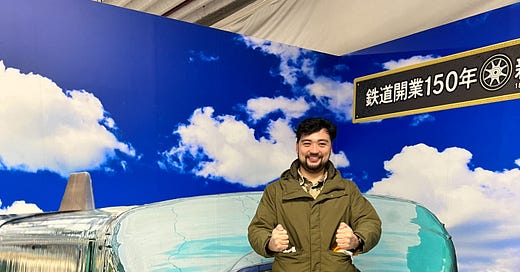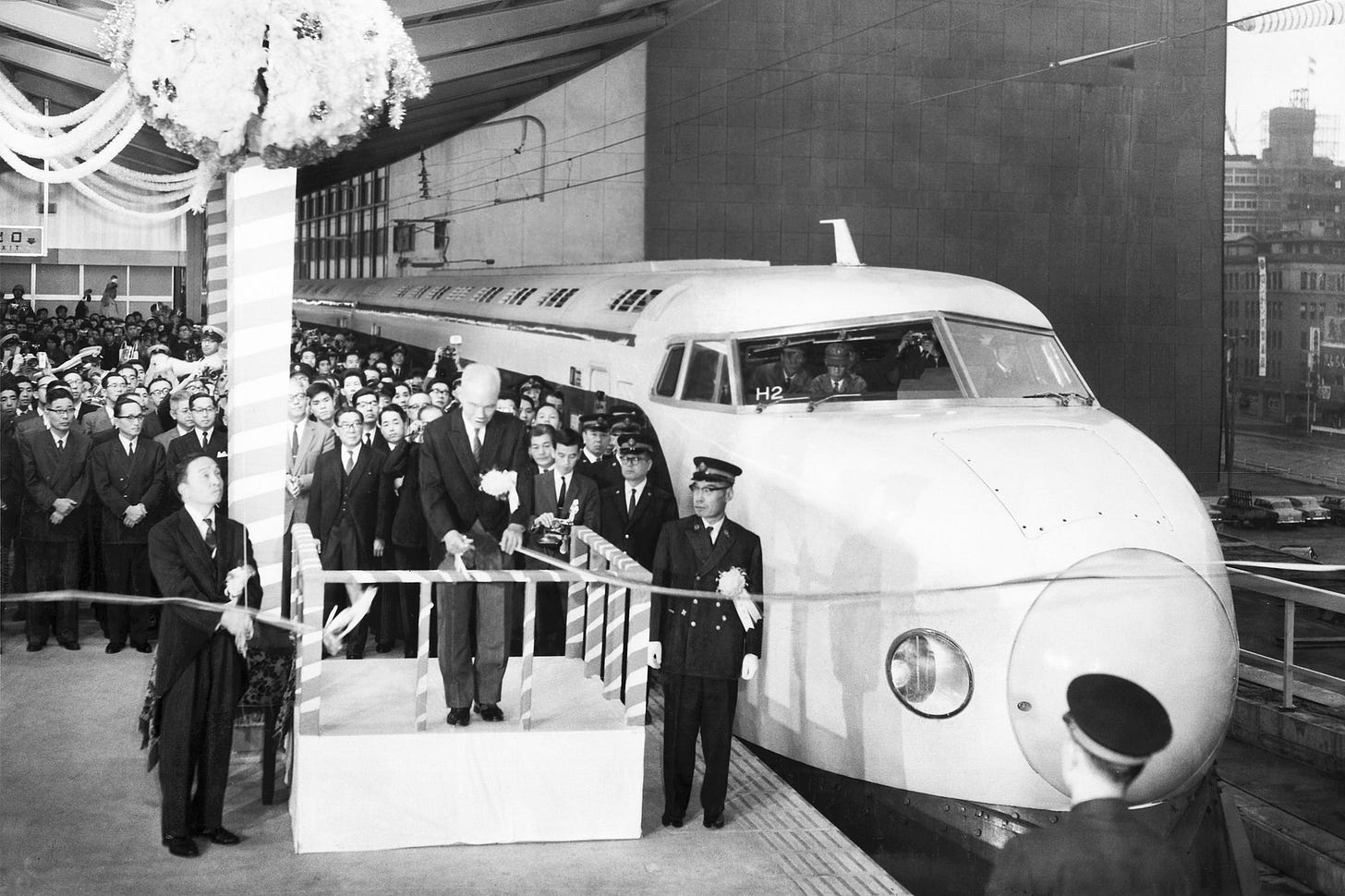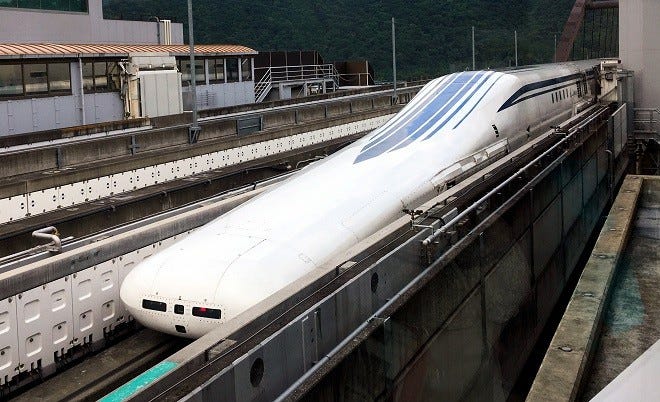Today marks the 60th anniversary of the Tokaido Shinkansen, arguably the first commercial high-speed rail system in history, which links Tokyo and Osaka. If you’ve ever been on the Shinkansen, you know it’s more than just a train—it’s hands down the best mode of transportation in the world. So quiet you can hear a pin drop, so stable you could balance a coin on its side. For anyone who loves trains, the Shinkansen is the gold standard, a symbol of precision, speed, and grace that has stood the test of time.
Since its launch in 1964, the Shinkansen has been much more than an engineering marvel. It redefined Japan’s relationship with time and distance. What was once a multi-day journey between Japan’s two largest cities was cut to just hours. The Shinkansen transformed the way people traveled, how they did business, and how cities interacted. It became a lifeline, connecting regions and fostering economic growth along the Tokaido corridor.
For those of us who follow public transit with a passion, the Shinkansen represents what great infrastructure can achieve. It’s the reason I’ve fallen in love with trains. It’s reliable, it’s efficient, and it’s downright enjoyable to ride. And six decades later, it’s still leading the way in a world that’s slowly catching up.
China's rise: Learning from the master
When talking about high speed rail, we can't ignore China.
In just a few decades, China has built the largest high-speed rail network in the world, with over 40,000 kilometers of track crisscrossing the country. It’s fast, efficient, and incredibly impressive. But it’s important to remember where it all started. China’s system owes much of its success to the Shinkansen. In the early 2000s, Chinese engineers worked closely with Japanese rail companies, importing the technology and expertise that allowed them to build their own high-speed empire.
I’ve ridden on China’s high-speed trains, and while they’re impressive in scale, there’s something about the Shinkansen that still feels unmatched. It’s not just the speed, though Japan’s top trains reach speeds of 320 kilometers per hour (200 mph). It’s the overall experience—the seamless coordination, the unshakable reliability, and the decades of refinement that you can feel when you step onboard. China may be expanding rapidly, but Japan’s Shinkansen remains the template.
With that said, I'm still incredibly happy to see the global rise of high-speed rail, and China’s network is proof that trains are the future. But no matter how large China’s system becomes, the Shinkansen will always be the original—the one that inspired the world to look at high-speed travel as a possibility, not just a dream.
The US: A case of missed opportunities
The US, unfortunately, has yet to embrace that dream. It’s painful to think about the opportunities lost in a country that once led the world in infrastructure innovation. Instead of high-speed trains connecting its cities, the US chose to invest in highways and airports, betting on cars and planes over rail.
The result? Endless traffic, crumbling roads, and a public transit system that lags behind much of the developed world.
And yet, there are glimmers of hope. California’s high-speed rail project, though delayed and over budget, represents the first real attempt to bring high-speed rail to the US.
The Texas Central Railway project, which plans to connect Dallas and Houston using Shinkansen technology, could be a game-changer if it ever breaks ground. But these projects face the same challenges that have plagued high-speed rail efforts for years: political opposition, legal battles, and financial uncertainty.
Even so, the logic of high-speed rail is undeniable. Expanding highways doesn’t solve congestion—it makes it worse. Adding lanes just means more cars. High-speed trains, on the other hand, offer a real solution. They’re faster, greener, and more efficient than any alternative. The fact that the US. is even considering high-speed rail in places like Texas, where cars reign supreme, shows just how much attitudes are shifting.
The Shinkansen’s future
So, what’s next for the Shinkansen?
Japan is betting on the Chuo Shinkansen, a maglev line that will eventually link Tokyo and Osaka at speeds of up to 500 kilometers per hour (310 mph). The first section, between Tokyo and Nagoya, is set to open by 2037. But even as this futuristic technology takes shape, the original Shinkansen shows no signs of slowing down.
In fact, the Shinkansen’s longevity is one of its most remarkable features. Despite Japan’s shrinking population and declining domestic travel demand, the Shinkansen remains profitable. JR Central, the operator of the Tokaido Shinkansen, continues to make money—an anomaly in a world where public transit systems often run at a loss. That profitability, combined with its unmatched safety record (not a single passenger fatality in 60 years), ensures that the Shinkansen will continue to be a cornerstone of Japan’s transportation network for decades to come.
Sustainability is another key focus. With climate change becoming an ever-pressing concern, Japan is looking for ways to make its trains even greener. The latest Shinkansen models are quieter, more energy-efficient, and increasingly powered by renewable energy. As the world looks for solutions to reduce carbon emissions, the Shinkansen serves as a model for how large-scale infrastructure can be both fast and sustainable.
A legacy of connection
For those of us who love public transit, the Shinkansen represents everything that trains should be. It’s not just about speed—it’s about connection. It’s about bringing people closer, shrinking distances, and making travel a joy rather than a burden. The Shinkansen has transformed Japan over the past 60 years, and its influence can be felt in high-speed rail systems across the world.
As I reflect on my own experiences riding the Shinkansen, I’m reminded of how transformative great infrastructure can be. It’s not just about getting from one place to another—it’s about the experience of the journey. It’s about the feeling you get when the train glides out of the station, when the world outside becomes a blur, and you realize that this is what travel should feel like. Smooth, fast, and effortless.
Sixty years later, the Shinkansen still captures that magic. And as we look to the future, I have no doubt that it will continue to lead the way, inspiring new generations of transit enthusiasts and proving that sometimes, the best way forward is the one that started it all.











